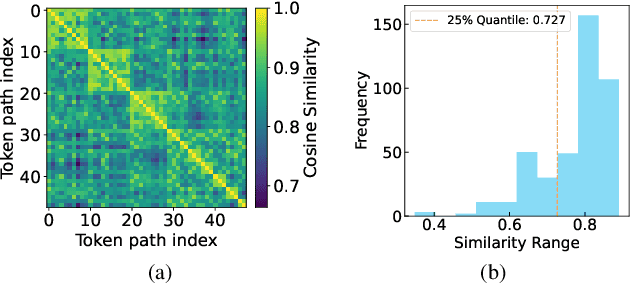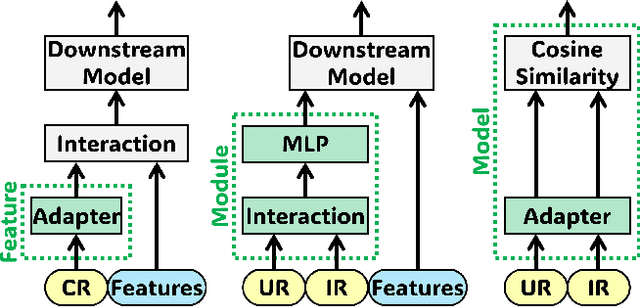Shu-Tao Xia
Splatwizard: A Benchmark Toolkit for 3D Gaussian Splatting Compression
Dec 31, 2025Abstract:The recent advent of 3D Gaussian Splatting (3DGS) has marked a significant breakthrough in real-time novel view synthesis. However, the rapid proliferation of 3DGS-based algorithms has created a pressing need for standardized and comprehensive evaluation tools, especially for compression task. Existing benchmarks often lack the specific metrics necessary to holistically assess the unique characteristics of different methods, such as rendering speed, rate distortion trade-offs memory efficiency, and geometric accuracy. To address this gap, we introduce Splatwizard, a unified benchmark toolkit designed specifically for benchmarking 3DGS compression models. Splatwizard provides an easy-to-use framework to implement new 3DGS compression model and utilize state-of-the-art techniques proposed by previous work. Besides, an integrated pipeline that automates the calculation of key performance indicators, including image-based quality metrics, chamfer distance of reconstruct mesh, rendering frame rates, and computational resource consumption is included in the framework as well. Code is available at https://github.com/splatwizard/splatwizard
Distribution-informed Online Conformal Prediction
Dec 08, 2025Abstract:Conformal prediction provides a pivotal and flexible technique for uncertainty quantification by constructing prediction sets with a predefined coverage rate. Many online conformal prediction methods have been developed to address data distribution shifts in fully adversarial environments, resulting in overly conservative prediction sets. We propose Conformal Optimistic Prediction (COP), an online conformal prediction algorithm incorporating underlying data pattern into the update rule. Through estimated cumulative distribution function of non-conformity scores, COP produces tighter prediction sets when predictable pattern exists, while retaining valid coverage guarantees even when estimates are inaccurate. We establish a joint bound on coverage and regret, which further confirms the validity of our approach. We also prove that COP achieves distribution-free, finite-sample coverage under arbitrary learning rates and can converge when scores are $i.i.d.$. The experimental results also show that COP can achieve valid coverage and construct shorter prediction intervals than other baselines.
VVS: Accelerating Speculative Decoding for Visual Autoregressive Generation via Partial Verification Skipping
Nov 17, 2025



Abstract:Visual autoregressive (AR) generation models have demonstrated strong potential for image generation, yet their next-token-prediction paradigm introduces considerable inference latency. Although speculative decoding (SD) has been proven effective for accelerating visual AR models, its "draft one step, then verify one step" paradigm prevents a direct reduction of the forward passes, thus restricting acceleration potential. Motivated by the visual token interchangeability, we for the first time to explore verification skipping in the SD process of visual AR model generation to explicitly cut the number of target model forward passes, thereby reducing inference latency. Based on an analysis of the drafting stage's characteristics, we observe that verification redundancy and stale feature reusability are key factors to retain generation quality and speedup for verification-free steps. Inspired by these two observations, we propose a novel SD framework VVS to accelerate visual AR generation via partial verification skipping, which integrates three complementary modules: (1) a verification-free token selector with dynamical truncation, (2) token-level feature caching and reuse, and (3) fine-grained skipped step scheduling. Consequently, VVS reduces the number of target model forward passes by a factor of $2.8\times$ relative to vanilla AR decoding while maintaining competitive generation quality, offering a superior speed-quality trade-off over conventional SD frameworks and revealing strong potential to reshape the SD paradigm.
CASL: Curvature-Augmented Self-supervised Learning for 3D Anomaly Detection
Nov 17, 2025Abstract:Deep learning-based 3D anomaly detection methods have demonstrated significant potential in industrial manufacturing. However, many approaches are specifically designed for anomaly detection tasks, which limits their generalizability to other 3D understanding tasks. In contrast, self-supervised point cloud models aim for general-purpose representation learning, yet our investigation reveals that these classical models are suboptimal at anomaly detection under the unified fine-tuning paradigm. This motivates us to develop a more generalizable 3D model that can effectively detect anomalies without relying on task-specific designs. Interestingly, we find that using only the curvature of each point as its anomaly score already outperforms several classical self-supervised and dedicated anomaly detection models, highlighting the critical role of curvature in 3D anomaly detection. In this paper, we propose a Curvature-Augmented Self-supervised Learning (CASL) framework based on a reconstruction paradigm. Built upon the classical U-Net architecture, our approach introduces multi-scale curvature prompts to guide the decoder in predicting the spatial coordinates of each point. Without relying on any dedicated anomaly detection mechanisms, it achieves leading detection performance through straightforward anomaly classification fine-tuning. Moreover, the learned representations generalize well to standard 3D understanding tasks such as point cloud classification. The code is available at https://github.com/zyh16143998882/CASL.
Improving Deepfake Detection with Reinforcement Learning-Based Adaptive Data Augmentation
Nov 10, 2025Abstract:The generalization capability of deepfake detectors is critical for real-world use. Data augmentation via synthetic fake face generation effectively enhances generalization, yet current SoTA methods rely on fixed strategies-raising a key question: Is a single static augmentation sufficient, or does the diversity of forgery features demand dynamic approaches? We argue existing methods overlook the evolving complexity of real-world forgeries (e.g., facial warping, expression manipulation), which fixed policies cannot fully simulate. To address this, we propose CRDA (Curriculum Reinforcement-Learning Data Augmentation), a novel framework guiding detectors to progressively master multi-domain forgery features from simple to complex. CRDA synthesizes augmented samples via a configurable pool of forgery operations and dynamically generates adversarial samples tailored to the detector's current learning state. Central to our approach is integrating reinforcement learning (RL) and causal inference. An RL agent dynamically selects augmentation actions based on detector performance to efficiently explore the vast augmentation space, adapting to increasingly challenging forgeries. Simultaneously, the agent introduces action space variations to generate heterogeneous forgery patterns, guided by causal inference to mitigate spurious correlations-suppressing task-irrelevant biases and focusing on causally invariant features. This integration ensures robust generalization by decoupling synthetic augmentation patterns from the model's learned representations. Extensive experiments show our method significantly improves detector generalizability, outperforming SOTA methods across multiple cross-domain datasets.
Imperceptible Jailbreaking against Large Language Models
Oct 06, 2025Abstract:Jailbreaking attacks on the vision modality typically rely on imperceptible adversarial perturbations, whereas attacks on the textual modality are generally assumed to require visible modifications (e.g., non-semantic suffixes). In this paper, we introduce imperceptible jailbreaks that exploit a class of Unicode characters called variation selectors. By appending invisible variation selectors to malicious questions, the jailbreak prompts appear visually identical to original malicious questions on screen, while their tokenization is "secretly" altered. We propose a chain-of-search pipeline to generate such adversarial suffixes to induce harmful responses. Our experiments show that our imperceptible jailbreaks achieve high attack success rates against four aligned LLMs and generalize to prompt injection attacks, all without producing any visible modifications in the written prompt. Our code is available at https://github.com/sail-sg/imperceptible-jailbreaks.
Closing the Safety Gap: Surgical Concept Erasure in Visual Autoregressive Models
Sep 26, 2025Abstract:The rapid progress of visual autoregressive (VAR) models has brought new opportunities for text-to-image generation, but also heightened safety concerns. Existing concept erasure techniques, primarily designed for diffusion models, fail to generalize to VARs due to their next-scale token prediction paradigm. In this paper, we first propose a novel VAR Erasure framework VARE that enables stable concept erasure in VAR models by leveraging auxiliary visual tokens to reduce fine-tuning intensity. Building upon this, we introduce S-VARE, a novel and effective concept erasure method designed for VAR, which incorporates a filtered cross entropy loss to precisely identify and minimally adjust unsafe visual tokens, along with a preservation loss to maintain semantic fidelity, addressing the issues such as language drift and reduced diversity introduce by na\"ive fine-tuning. Extensive experiments demonstrate that our approach achieves surgical concept erasure while preserving generation quality, thereby closing the safety gap in autoregressive text-to-image generation by earlier methods.
Enhancing Retrieval Augmentation via Adversarial Collaboration
Sep 18, 2025Abstract:Retrieval-augmented Generation (RAG) is a prevalent approach for domain-specific LLMs, yet it is often plagued by "Retrieval Hallucinations"--a phenomenon where fine-tuned models fail to recognize and act upon poor-quality retrieved documents, thus undermining performance. To address this, we propose the Adversarial Collaboration RAG (AC-RAG) framework. AC-RAG employs two heterogeneous agents: a generalist Detector that identifies knowledge gaps, and a domain-specialized Resolver that provides precise solutions. Guided by a moderator, these agents engage in an adversarial collaboration, where the Detector's persistent questioning challenges the Resolver's expertise. This dynamic process allows for iterative problem dissection and refined knowledge retrieval. Extensive experiments show that AC-RAG significantly improves retrieval accuracy and outperforms state-of-the-art RAG methods across various vertical domains.
Large Foundation Model for Ads Recommendation
Aug 20, 2025



Abstract:Online advertising relies on accurate recommendation models, with recent advances using pre-trained large-scale foundation models (LFMs) to capture users' general interests across multiple scenarios and tasks. However, existing methods have critical limitations: they extract and transfer only user representations (URs), ignoring valuable item representations (IRs) and user-item cross representations (CRs); and they simply use a UR as a feature in downstream applications, which fails to bridge upstream-downstream gaps and overlooks more transfer granularities. In this paper, we propose LFM4Ads, an All-Representation Multi-Granularity transfer framework for ads recommendation. It first comprehensively transfers URs, IRs, and CRs, i.e., all available representations in the pre-trained foundation model. To effectively utilize the CRs, it identifies the optimal extraction layer and aggregates them into transferable coarse-grained forms. Furthermore, we enhance the transferability via multi-granularity mechanisms: non-linear adapters for feature-level transfer, an Isomorphic Interaction Module for module-level transfer, and Standalone Retrieval for model-level transfer. LFM4Ads has been successfully deployed in Tencent's industrial-scale advertising platform, processing tens of billions of daily samples while maintaining terabyte-scale model parameters with billions of sparse embedding keys across approximately two thousand features. Since its production deployment in Q4 2024, LFM4Ads has achieved 10+ successful production launches across various advertising scenarios, including primary ones like Weixin Moments and Channels. These launches achieve an overall GMV lift of 2.45% across the entire platform, translating to estimated annual revenue increases in the hundreds of millions of dollars.
PMA: Towards Parameter-Efficient Point Cloud Understanding via Point Mamba Adapter
May 27, 2025Abstract:Applying pre-trained models to assist point cloud understanding has recently become a mainstream paradigm in 3D perception. However, existing application strategies are straightforward, utilizing only the final output of the pre-trained model for various task heads. It neglects the rich complementary information in the intermediate layer, thereby failing to fully unlock the potential of pre-trained models. To overcome this limitation, we propose an orthogonal solution: Point Mamba Adapter (PMA), which constructs an ordered feature sequence from all layers of the pre-trained model and leverages Mamba to fuse all complementary semantics, thereby promoting comprehensive point cloud understanding. Constructing this ordered sequence is non-trivial due to the inherent isotropy of 3D space. Therefore, we further propose a geometry-constrained gate prompt generator (G2PG) shared across different layers, which applies shared geometric constraints to the output gates of the Mamba and dynamically optimizes the spatial order, thus enabling more effective integration of multi-layer information. Extensive experiments conducted on challenging point cloud datasets across various tasks demonstrate that our PMA elevates the capability for point cloud understanding to a new level by fusing diverse complementary intermediate features. Code is available at https://github.com/zyh16143998882/PMA.
 Add to Chrome
Add to Chrome Add to Firefox
Add to Firefox Add to Edge
Add to Edge